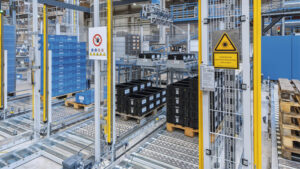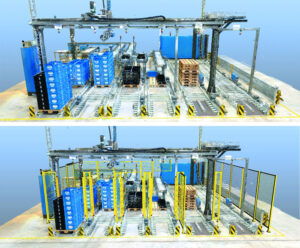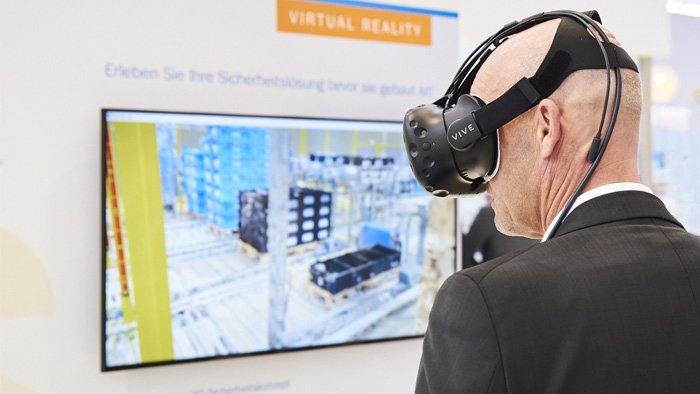3D model of the machine allows companies to update their older machines for the modern landscape
Improving safety in older machines is a necessity to maintain effective plant and machine safety. It is the responsibility of any business to provide safe working equipment, not only to protect employees, but also to improve the productivity of a machine. One way to make this process easier is by creating a 3D model of the machine. When considering how to go about updating an existing machine, three questions must be at the forefront of any manufacturer’s mind:
- Does the existing machine still meet all safety requirements?
- Have past modifications to the machine compromised its safety?
- How can retrofitting the state-of-the-art safety technology even be accomplished when the design drawings and CAD files are no longer available? (This is common in older machines)
SICK’s solution is a simple one: digitization of the machine into a 3D model. Doing this allows for adaptions in the design, as well as review and approval from any location. Creating a 3D model of a machine for a safety-related modification project is still a completely new approach in the market, but it is a completely logical solution. What you see is what you get, and sometimes, that’s all you need.
How to Retrofit Your Machines with Updated Safety Components
The machine is measured with a laser and digitized as a 3D model by the millimeter. Safety components, already available in CAD data form, are designed directly into the digitized machine. Operating sequences and production processes incorporating the selected safety measures can be fine-tuned in the 3D model. This enables particular details or restrictions to be identified early, and eliminates any surprises during the modification work and recommissioning.
Through better coordination upfront, the machine operator and SICK can optimize and efficiently schedule their resources during modification projects. Modification measures on existing machines either have design drawings or CAD data available or they do not.
 Furthermore, many operators have very little or no training when it comes to planning, managing and implementing safety measures. Having the necessary knowledge of the relevant and latest guidelines and standards is a challenge that should not be underestimated. There is where SICK can help.
Furthermore, many operators have very little or no training when it comes to planning, managing and implementing safety measures. Having the necessary knowledge of the relevant and latest guidelines and standards is a challenge that should not be underestimated. There is where SICK can help.
Solving Your Safety Needs
As an experienced supplier of safety retrofitting and modernization services, SICK provides single-source solutions and a comprehensive product portfolio. All of this is done with a high level of application expertise and knowledge of the currently applicable standards. Operators therefore receive not only improved safety technology, but also suitable protection against liability.
When you have identified the need for a safety upgrade for a machine, do not delay the implementation of that upgrade. This is to ensure the safety of the machine and to avoid work accidents.
The Old, Stressful Procedure
If drawings or CAD data are available, planning of the modification measures can commence immediately with the help of the existing measurements. However, there are still numerous impediments that could make a quick implementation difficult. This includes time-consuming and costly on-site meetings, not to mention the potential delay caused in global projects.
The complicated and timely identification and clarification of any misunderstandings regarding operation-related technical issues, or difficulties in gaining acceptance for the implemented measures, are further difficulties on the path to obtaining a safe piece of equipment. Existing machines for which no drawings or CAD data are available have – in the past, at least – required the time-consuming collection of design details on-site before specific risk-reduction measures could be considered.
This includes manual measurement and photographic documentation of the machine, as well as the environment in which it is installed. If no wiring diagrams exist, the current status of the complete electrical system needs to be determined. This applies also to post-commissioning modifications that have been inadequately documented, either on paper or electronically.
This work, although important, is strenuous. SICK believes digitization is the best way to simplify the process.
Say Goodbye to Stress and Expense
With the 3D scan concept from SICK as a turn-key solution, it is now possible to significantly reduce the cost of retrofitting a machine. It is simply digitized and modeled in 3D. Instead of spending hours or days determining the layout and dimensions of the machine, a virtual representation of the actual machine can now be created in just one morning.
A measuring laser scanner first captures images of the machine in the production hall from an arbitrary number of positions. The digital measurement data are assembly by the scanner software in just a few seconds into a millimeter accurate, color 3D model of the machine.
Formatted as an AutoCAD file, the data can be used immediately in the 3D CAD software for virtual planning of the safety measures. The customer very quickly obtains a clear impression of what the machine will look like. He can also directly incorporate any specific requirements of his own.
Test Your Technology Virtually in 3D
By simply wearing VR goggles, anyone can inspect the machine and all of its components. This becomes particularly exciting once the machine in the model has been equipped with the new safety technology.
All products in the SICK portfolio as well as a large number of physical guards have been stored as 3D models. They can be virtually installed in the machine in the required design, configuration or dimensions via drag and drop.
The warning and protective fields of safety laser scanners can also be visualized graphically. The same applies to the height and location of safety fences, or the ideal arrangement of gates in the fence or at access points to the machine. Furthermore, it is possible develop and compare alternate safety concepts for the machine.
Machine operators, production managers, safety specialists, and integrators will now easily have reliable answers to questions such as, “Which safety design has what effect on the machine footprint?” or “Which safety measures also optimize the ergonomics of operation or specific machine processes?”
Once the user has put on his VR goggles, the machine can then be experienced with the proposed safety solution. This in turn makes it possible to check the choice, location or function of the as-yet virtually selected safety technology. Any remaining safety gaps such as shadowed areas in scanner fields or access areas behind the machine can be identified in a timely manner.
Once the manufacturer-neutral safety concept has been approved, a parts list matching the 3D model of the machine can be created for the purposes of purchasing the required hardware.
An Efficiency Benchmark for Safe Machine Construction
The innovative methodology of 3D scanning eliminates virtually all of the challenges for an efficient safety retrofit of existing machines. The laser measurement greatly simplifies the collection and processing of machine data.
As a result, on-site inspections become significantly shorter and less often necessary. Large distances and time differences no longer present a problem because the proposed solution can be discussed and agreed on based on the 3D model in a phone conference over the Internet anywhere and at any time of day.
Any misconceptions or incorrect interpretations of safety- or operation-related aspects can to a large extent be resolved on the digitized machine. They do not need to be solved later during integration and commissioning through time-consuming and unplanned modifications on-site. All this substantially shortens the duration of the retrofitting project.
Furthermore, all persons involved in the project are familiarized with the modified machine in the virtual machine safeguarding evaluation. For operators in particular, this increases the acceptance of the modification measures and therefore minimizes the risk of manipulation of the safety technology.
With all these advantages that the digitization of a machine as a 3D model provides, SICK is setting a new benchmark in the area of safety retrofitting. Added to this, the operator commissioning the work has only one contact person throughout the entire project – the person from SICK.
At the same time, a worldwide network of more than 150 safety application specialists ensure that the latest technologies, products, solutions and services as well as expertise and application know-how are available globally.





